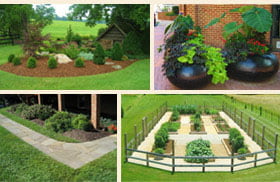
Much Ado About Mulch
Mulch is an endlessly useful product for the gardener or landscaper. Used properly, it can keep moisture in the soil, promote larger, healthier plants, repel bugs, and improve the appearance of your garden or yard. There are many different kinds and lots of ways to use it. You can use this helpful guide to make the most of mulch!
What Kind of Mulch?
Where you use mulch and what you intend to plant in it will help you determine what kind you will need. Double shredded hardwood mulch is aged for use around plantings, and provides an attractive backdrop for your landscaping. Cedar mulches are extremely useful in repelling insects, perfect around established plants like rhododendrons, azaleas, and roses. All mulches need to be aged (dark in color) to prevent burning of young plants. A blend of hardwood and pine allows you to have the best of both mulches.
If you are covering a large area or a steep slope, you might want to consider single shredded hardwood mulch, as it is less likely to drift. Cedar mulch mats, making it a great choice for high traffic areas or hillsides. Playground mulch is made of high-quality oak chips, making it ideal for play areas, picnic areas, and walkways.
Colored (dyed) mulches can add refinement and color to your landscaping. Mulching will help with preventing weeds and keeping plant roots moist. Alternatively, if you are covering a large area or preventing weeds outside of a fenced-in yard, coarse hardwood mulch may be your best choice. And if you mulch twice a year, compost is a better choice for fall. We have a blend mulch mixed with our WDR Compost for year-round feeding of your plants
When to Mulch
Most gardeners prefer to put mulch down in the spring, after the soil has begun to warm. Mulch insulates the soil and helps it to retain moisture, so you get the best benefit once the soil has thawed and has been warmed by the early spring sunshine.
If you have previously applied mulch, remove what you can from the surface before adding new mulch. Remove weeds and any dead plants from the area and rake away the old mulch. To add nutrients to the soil, work compost into the first inch or two of the topsoil. Add mulch to a 3 inch depth and leave a little space around young plants so they won’t be burned.
Some gardeners like to mulch in the fall as well, although it is even more beneficial to apply compost to ready the soil for spring. Remove any dead plants that have finished for the season and remove the old mulch to prevent fungi and bacteria from being trapped in your garden. Add up to 3 inches of compost to help add nutrients to the soil in preparation for spring.
How Long Does Mulch Last?
In areas like walkways and playgrounds, there is no need to remove and replace mulch every season as you would with a garden or flower bed. Playground mulch can simply be added to as needed for 2-3 years to maintain depth. Walkways and decorative landscaping may need to be replaced every 1-2 years. Cedar mulch can sometimes last as long as 3 years but will discolor with time.
If you want mulch that is low maintenance and lasts, look for material that is coarse, with larger pieces of wood and bark. Colored mulch is dyed, and as time and weather affect it, the color will fade slightly, so if you are intent upon maintaining a certain color, you will want to add or replace regularly to keep it looking fresh.
Mulch can be useful in so many ways! The color and the versatility of mulch can allow you to be creative with your landscape with minimal effort after application. Mulch also cuts down on weeding and watering time. We offer a wide variety of useful and attractive products to help you achieve the results you want – visit our mulch products to learn more!
